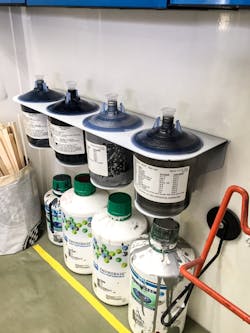THE INSPIRATION: It started with wanting to save space and declutter the shop by finding an efficient way to store the 3M Paint Preparation System (PPS) cups and liners of Detroit Auto Body. Eddie Stokes, president and owner, began brainstorming for a solution. After thinking it over for a few months, he came up with an idea that would not only clean his shop up, but also keep the mixed paint from folding over in the liners while waiting to be loaded into the hard-case shell, keep the cup lids snapped on, and create an efficient system for the whole day.
WHAT IT DOES: The quick-shot rack, as Stokes calls it, holds four PPS cup liners or cups. The team averages anywhere from five to six paint jobs each the morning and the same in the afternoon, so the rack only needs to be loaded a few times per day; whereas before, they were mixing paint before every job.
At the start of each day, the employee mixing color looks at the upcoming jobs, which are each assigned some sort of identifier—a label or number depending on the staff member—and then the designated color required for the job. The paint for each vehicle is mixed into a designated PPS cup liner for each of the morning jobs. All of the morning jobs are then loaded, in order, into the slots on the quick-shot rack. The painter then has all of the color lined up for the morning and the process repeats in the afternoon.
SHOP: Detroit Auto Body Inc.
LOCATION: Covina, Calif.
OWNER: Eddie Stokes, president
SIZE: 14,000 square feet
STAFF: 17
AVERAGE MONTHLY CAR COUNT: 120
ANNUAL REVENUE: $3.2 million
HOW IT’S MADE: Although there are products that are similar to the quick-shot rack, Stokes didn’t like the shape of the holders available in the market. He wanted a rack that had a circular holder that could be attached to the wall, which was not available.
Knowing what he wanted, he came up with a template design in his head and then he outsourced the project to someone who could assist him with the laser cutting needed for the four-slot design.
THE COST: The cost of the steel needed to make the rack is about $15. Stokes was able to find someone to help him with the laser cutting, which cut down cost.
THE RETURN: “We’re able to get a least an extra car through a day,” says Stokes. “With this setup, the tech can mix colors for four cars at a time and not have to walk back and forth between every job, which takes booth time down to an average of 45 minutes when it was an hour before.”

